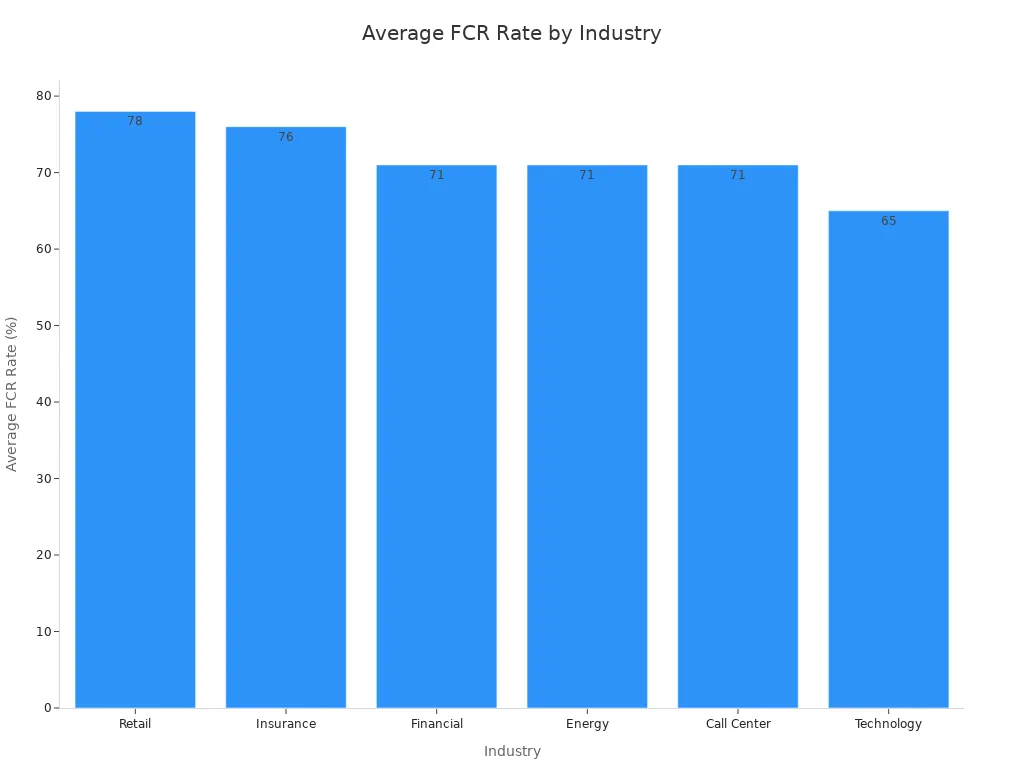Improve CSAT With First Call Resolution Today

You want to boost customer satisfaction. Improving First Call Resolution (FCR) is your most powerful strategy. Resolving issues on the first contact creates a positive customer experience and builds loyalty. Getting it wrong, however, is a major risk.
Poor customer service contributes to an average of 14% of customer churn.
Understanding what is first call resolution is your first step toward success. The right technology, like the Sobot call center powered by Sobot AI, gives you the tools to succeed. Sobot helps you delight customers from the very first interaction.
What is First Call Resolution?

You hear the term often, but what is first call resolution (FCR)? It is a key performance indicator (KPI) that measures your team's ability to resolve a customer's issue completely during their first interaction. No follow-up calls, emails, or transfers are needed. The problem is solved, and the customer is satisfied.
Defining the Metric
You can easily calculate your FCR rate. The standard industry formula is: (Total Contacts Resolved on First Contact ÷ Total Contacts) × 100. A higher percentage means your team is more efficient and effective. Understanding what is first call resolution helps you set clear goals.
Different industries have different benchmarks. Knowing where you stand helps you identify opportunities for improvement.
| Industry | Average FCR Rate |
|---|---|
| Retail | 78% |
| Insurance | 76% |
| Financial | 71% |
| Energy | 71% |
| Technology | 65% |
| Call Center | 71% |

Why It Matters More Than Ever
Today's customers have high expectations. They are used to fast, one-click solutions in other areas of their lives. This mindset now applies to customer service.
Customers now expect convenience, speed, and resolution on the first try, a phenomenon often referred to as the 'Amazon effect'. Consequently, contact centers are advised to 'Track effort scores, digital channel first contact resolution, and agent satisfaction alongside traditional KPIs' to meet these evolving demands.
Failing to meet these expectations has real consequences. Speed and convenience are no longer just nice-to-haves; they are essential. Knowing what is first call resolution is the first step to meeting these demands.
- Nearly 80% of American consumers say speed is a crucial part of a positive experience.
- For younger generations like Gen Z, instant service is a basic expectation.
- A stunning 17% of customers will leave a brand after just one bad experience.
A high FCR rate shows you value your customers' time. It proves your commitment to providing excellent, efficient service.
Why FCR is Critical for CSAT

A high FCR rate does more than just look good on a report. It is a powerful lever you can pull to directly influence customer satisfaction. When you solve a problem on the first try, you are not just closing a ticket; you are building a stronger, more profitable relationship with your customer. This single metric impacts customer effort, trust, and your overall brand perception.
Reduce Customer Effort
Today's customers want easy answers. They do not want to repeat their problem to multiple agents or wait days for a follow-up. A low-effort experience is a high-satisfaction experience. Focusing on FCR is the most direct way you can reduce the work your customers have to do.
When you resolve an issue on the first contact, you:
- Conserve your customer's valuable time.
- Create an efficient, friction-free support interaction.
- Leave a lasting positive impression of your brand's efficiency.
This efficiency also has a major impact on your operational costs. Every follow-up call you avoid saves money. The average customer service call can cost between $2.70 and $5.60. By resolving issues on the first contact, you eliminate these repeat costs and free up your agents to handle new inquiries, boosting overall productivity.
Build Customer Trust and Loyalty
Trust is the foundation of customer loyalty. Every interaction is a chance to either build or erode that trust. When you solve a customer's problem quickly and competently on the first try, you send a clear message: "We are reliable, we are capable, and we value you."
High FCR rates directly contribute to a stronger brand reputation.
- You save customers time and prevent the frustration of multiple contacts.
- You demonstrate your company's competence and commitment to service.
- You strengthen the trust that is crucial for customer retention.
FCR is a perception metric. It directly measures how customers feel about their interaction with your support team. A successful first call makes customers feel heard and respected, transforming a negative situation into a trust-building moment.
Create Positive Brand Perceptions
Your brand's reputation is shaped by thousands of individual customer experiences. A single frustrating support call can lead to a negative online review, but a single great one can create a brand advocate. Understanding what is first call resolution is the key to turning your service center into a reputation-building engine.
When you deliver positive FCR experiences, you unlock powerful benefits.
- Inspire Brand Ambassadors: Happy customers share their stories. Efficient problem-solving encourages them to advocate for your brand online and to their friends.
- Reduce Negative Publicity: You solve issues before they escalate into public complaints on social media or review sites.
- Attract New Customers: A strong public reputation for excellent customer service, driven by high FCR, reinforces trust and can directly increase your market share.
Instead of your brand being known for long wait times or unresolved issues, it becomes known for effectiveness. This positive word-of-mouth mends your brand's reputation and attracts new business, proving that great service is great marketing.
How to Improve Your FCR Rate
Knowing that a high FCR rate boosts CSAT is one thing; achieving it is another. You need a clear, actionable plan. Improving your First Call Resolution rate involves a multi-faceted approach that combines empowering your people, organizing your information, streamlining your processes, and leveraging the right tools. By focusing on these four key areas, you can transform your support operations and deliver the one-touch resolutions customers expect.
Empower Agents with Training
Your agents are on the front lines. Their confidence and competence directly determine your FCR rate. You must invest in comprehensive training that goes beyond basic scripts. Empowered agents are problem-solvers, not just call-handlers.
Excellent training programs focus on building both hard and soft skills. To truly improve First Call Resolution, your training should include:
- Product and Service Mastery: Agents need to be true experts. They must understand the 'why' behind your products, not just memorize features. This turns them into trusted advisors who can solve complex problems.
- Soft Skills Development: Crucial skills like empathy, patience, and active listening are non-negotiable. Train agents to acknowledge a customer's frustration with phrases like, "I understand how frustrating this is, and I’m here to help you solve it." This changes the dynamic from confrontational to collaborative.
- Systems and Technology Fluency: Your agents should navigate your CRM, knowledge base, and communication tools effortlessly. Hands-on practice in a simulated environment makes using these tools second nature.
Tip: Use a blended learning model. Combine self-paced online modules for policies with live role-playing sessions for handling difficult customers. You can even use gamification with points and leaderboards to make training more engaging and effective.
Centralize Information Access
Even the best-trained agent cannot resolve an issue if they cannot find the right information quickly. A scattered, outdated, or hard-to-navigate knowledge base is a major barrier to First Call Resolution. You need to create a single source of truth that gives your team instant access to accurate answers.
Building an effective knowledge base is a strategic process.
- Determine Which Questions to Answer: Start by analyzing your support tickets to find the most frequently asked questions. Talk to your sales and support teams to gather insights directly from customer-facing staff.
- Design an Optimal Structure: Your knowledge base must be easy to search. A prominent search bar is essential. You can organize content by common customer queries, such as "orders," "returns," and "shipping."
- Select Your Contributors: Involve team members who interact with customers daily. Their input is invaluable. For technical accuracy, include product managers and engineers in the content creation and review process.
When you integrate this centralized knowledge base with your CRM, you give your agents a 360-degree view of the customer. They can see past purchases, previous support tickets, and interaction history in one unified workspace. This context eliminates the need for customers to repeat themselves and empowers agents to provide a personalized, fast, and complete solution on the first contact.
Optimize Internal Workflows
Sometimes, the problem isn't the agent or the information; it's the process. Complicated or broken internal workflows create frustrating roadblocks that make a first-call fix impossible. You must identify and eliminate these bottlenecks to pave a smooth path to resolution.
Common bottlenecks that prevent a high FCR rate include:
- Complex issues that require escalation to a specialist.
- Policy constraints that prevent an agent from resolving the issue immediately.
- Inconsistent information given to customers across different touchpoints.
- Process gaps that force agents to ask for help or transfer the call.
To fix this, you need to map out your customer support journey from start to finish. Where do customers get stuck? At what points are agents forced to escalate a call? By identifying these friction points, you can redesign your workflows for efficiency. This might mean giving agents more authority to solve common problems, creating clearer escalation paths for truly complex issues, or using technology to automate routine tasks.
Leverage Modern Technology
Modern technology is the glue that holds your FCR strategy together. It empowers your agents, centralizes your data, and automates your workflows. The right tech stack can dramatically increase your First Call Resolution rate, often with immediate impact.
AI-powered tools are particularly effective. They work alongside your agents, making them smarter and faster.
- Real-Time Agent Assistance: AI can analyze a live conversation and automatically suggest relevant articles from your knowledge base, guide agents with next-best-action recommendations, and provide instant access to customer history.
- Intelligent Call Routing: Instead of random assignment, AI can route a customer to the agent best equipped to handle their specific issue based on skill, language, and past interactions. This reduces transfers and improves the chance of a first-contact fix.
- Predictive Analytics: This technology is a true game-changer. By analyzing historical data, you can anticipate customer needs before they even call.
By embracing these technologies, you equip your team to move from a reactive to a proactive support model, solving problems faster and boosting your First Call Resolution rate by as much as 5%.

How Sobot's Call Center Boosts FCR
The strategies for improving your FCR rate—empowering agents, centralizing data, and optimizing workflows—all depend on one thing: the right technology. You need a platform that brings these elements together. Sobot's Voice/Call Center is the comprehensive solution designed to make high First Call Resolution a reality for your team.
Just ask Weee!, America's largest online Asian supermarket. By implementing Sobot, they reduced their resolution time by 50% and achieved an incredible 96% CSAT score. You can achieve similar results by leveraging a platform built for efficiency.
Unify Data with an Integrated Workspace
Your agents cannot solve problems quickly if they are busy switching between tabs. Sobot's Unified Workspace eliminates this friction. It integrates all your tools, data, and communication channels into a single, intuitive interface.
This AI-enhanced workspace gives your agents a complete view of the customer journey. They can see past tickets, chat history, and order information in one place. This eliminates the need for customers to repeat themselves and empowers your team to find the right answer on the first try.
Route Calls Intelligently with IVR
A frustrating phone menu is a guaranteed way to lower customer satisfaction. Sobot's intelligent IVR ensures your customers get to the right person from the start. You can use the simple drag-and-drop interface to build a smart and efficient call flow.
Follow best practices with ease:
- Prioritize popular options to help most callers faster.
- Use clear, simple language so customers know exactly which option to choose.
- Route calls based on agent skills, ensuring the most qualified person handles the inquiry.
This smart routing minimizes transfers and is a critical step toward achieving First Call Resolution.
Gain Insights with Real-time Analytics
You cannot fix problems you cannot see. Sobot provides a powerful analytics dashboard that gives you real-time insights into your call center's performance. You can instantly see why customers are calling back and identify the root causes of recurring issues.
This data is your key to continuous improvement. Track essential KPIs like First Call Resolution, Average Handle Time, and CSAT to understand agent performance. Use these insights to provide targeted coaching, update your knowledge base, and make data-driven decisions that directly boost your FCR rate and customer satisfaction.
You now see that improving First Call Resolution is your most direct path to higher customer satisfaction. You can achieve this by empowering your agents and optimizing your workflows. A powerful platform like Sobot brings it all together. It uses AI and omnichannel technology to create a seamless experience, resolving issues on the first contact. This is the future of customer service.
Ready to boost your CSAT? Embark on your contact journey with Sobot today.
FAQ
What is a good First Call Resolution rate?
You should aim for an FCR rate between 70% and 79%. This is the industry average. However, the best rate for you depends on your industry and product complexity. Use the industry benchmark as your starting point and always strive for continuous improvement.
How does FCR impact agent satisfaction?
A high First Call Resolution rate empowers your agents. When you give them the right tools and training to solve problems on the first try, they feel more competent and successful. This reduces their stress and boosts morale, leading to lower agent turnover.
Can I improve FCR without new technology?
You can make some progress by improving agent training and internal processes. However, modern technology acts as a powerful force multiplier.
Tools like an integrated workspace and smart call routing provide the support your team needs to achieve a truly excellent First Call Resolution rate.
How do I start measuring First Call Resolution?
You can start today. Use the standard formula: (Total calls resolved on the first try ÷ Total number of calls) × 100. Your call center software should help you track this. This simple metric gives you a clear baseline to measure your improvement against.
See Also
Elevating Call Center Performance Through Strategic Monitoring and Analytics
Implementing Top-Tier Quality Management for Superior Call Center Operations
Artificial Intelligence Agents: Revolutionizing Customer Service and Support Experiences
Optimizing 24/7 Live Chat: Enhancing Efficiency for Seamless Customer Interactions
A 10-Step Guide to Implementing Effective Omnichannel Contact Center Solutions
